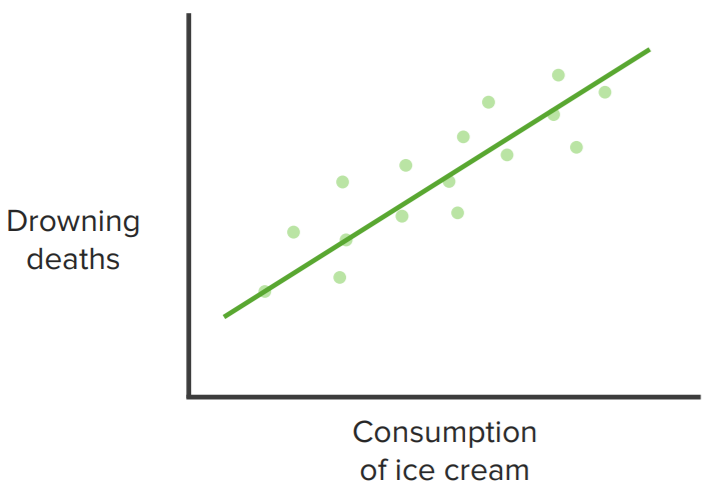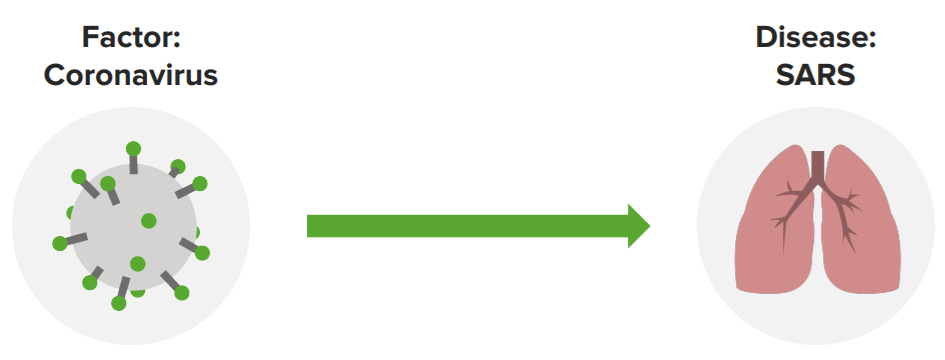Causality is a relationship Relationship A connection, association, or involvement between 2 or more parties. Clinician–Patient Relationship between 2 events in which 1 event causes the other. Simply because relationships are observed between 2 variables (i.e., associations or correlations) does not imply that one variable Variable Variables represent information about something that can change. The design of the measurement scales, or of the methods for obtaining information, will determine the data gathered and the characteristics of that data. As a result, a variable can be qualitative or quantitative, and may be further classified into subgroups. Types of Variables actually caused the outcome. Demonstrating causality between an exposure and an outcome is the main objective of most published medical research Research Critical and exhaustive investigation or experimentation, having for its aim the discovery of new facts and their correct interpretation, the revision of accepted conclusions, theories, or laws in the light of newly discovered facts, or the practical application of such new or revised conclusions, theories, or laws. Conflict of Interest. To ensure causality exists and is not an artifact of a flawed study design or other factors, various criteria must be met MET Preoperative Care while showing the reproducibility (reliability), internal congruence (internal validity), and generalizability (external validity) of the study.
Last updated: Aug 8, 2022
Causality is the relationship Relationship A connection, association, or involvement between 2 or more parties. Clinician–Patient Relationship between cause and effect.
“Correlation is not causation.”
Example:
Below is a graph depicting the relationship Relationship A connection, association, or involvement between 2 or more parties. Clinician–Patient Relationship between drowning Drowning Drowning occurs due to respiratory impairment from submersion or immersion in a liquid medium. Aspiration of water leads to hypoxemia, which affects all organ systems, resulting in respiratory insufficiency and acute respiratory distress syndrome (ARDS), cardiac arrhythmias, and neuronal damage. Drowning deaths and eating ice cream. As ice cream consumption goes up, so do drowning Drowning Drowning occurs due to respiratory impairment from submersion or immersion in a liquid medium. Aspiration of water leads to hypoxemia, which affects all organ systems, resulting in respiratory insufficiency and acute respiratory distress syndrome (ARDS), cardiac arrhythmias, and neuronal damage. Drowning deaths. However, this study is only showing a correlation rather than causation. Eating ice cream does not cause drowning Drowning Drowning occurs due to respiratory impairment from submersion or immersion in a liquid medium. Aspiration of water leads to hypoxemia, which affects all organ systems, resulting in respiratory insufficiency and acute respiratory distress syndrome (ARDS), cardiac arrhythmias, and neuronal damage. Drowning deaths. Rather, on hot days, people are more likely to eat ice cream, and they are more likely to go to the beach and drown. Thus, temperature is a confounding factor, leading to an observed relationship Relationship A connection, association, or involvement between 2 or more parties. Clinician–Patient Relationship when in reality there is no causality.

Example graph showing a correlation between events (rather than causation)
Image by Lecturio. License: CC BY-NC-SA 4.0Background:
The 9 principles:
As seen in the table below, a majority of the principles are satisfied, so you can be reasonably sure that smoking Smoking Willful or deliberate act of inhaling and exhaling smoke from burning substances or agents held by hand. Interstitial Lung Diseases actually causes lung cancer Lung cancer Lung cancer is the malignant transformation of lung tissue and the leading cause of cancer-related deaths. The majority of cases are associated with long-term smoking. The disease is generally classified histologically as either small cell lung cancer or non-small cell lung cancer. Symptoms include cough, dyspnea, weight loss, and chest discomfort. Lung Cancer.
| Principle | Principle satisfied | Explanation |
|---|---|---|
| Strength | Yes | There is a strong relative risk Relative risk Relative risk (RR) is the risk of a disease or condition occurring in a group or population with a particular exposure relative to a control (unexposed) group. Measures of Risk ( RR RR Relative risk (RR) is the risk of a disease or condition occurring in a group or population with a particular exposure relative to a control (unexposed) group. Measures of Risk) association between smoking Smoking Willful or deliberate act of inhaling and exhaling smoke from burning substances or agents held by hand. Interstitial Lung Diseases and lung cancer Lung cancer Lung cancer is the malignant transformation of lung tissue and the leading cause of cancer-related deaths. The majority of cases are associated with long-term smoking. The disease is generally classified histologically as either small cell lung cancer or non-small cell lung cancer. Symptoms include cough, dyspnea, weight loss, and chest discomfort. Lung Cancer. |
| Consistency Consistency Dermatologic Examination | Yes | This ↑↑ RR RR Relative risk (RR) is the risk of a disease or condition occurring in a group or population with a particular exposure relative to a control (unexposed) group. Measures of Risk has been reproduced across many cohort studies Cohort studies Studies in which subsets of a defined population are identified. These groups may or may not be exposed to factors hypothesized to influence the probability of the occurrence of a particular disease or other outcome. Cohorts are defined populations which, as a whole, are followed in an attempt to determine distinguishing subgroup characteristics. Epidemiological Studies |
| Specificity | No | Smoking Smoking Willful or deliberate act of inhaling and exhaling smoke from burning substances or agents held by hand. Interstitial Lung Diseases can lead to many different outcomes, and other exposures can also lead to lung cancer Lung cancer Lung cancer is the malignant transformation of lung tissue and the leading cause of cancer-related deaths. The majority of cases are associated with long-term smoking. The disease is generally classified histologically as either small cell lung cancer or non-small cell lung cancer. Symptoms include cough, dyspnea, weight loss, and chest discomfort. Lung Cancer. |
| Temporality | Yes | Smoking Smoking Willful or deliberate act of inhaling and exhaling smoke from burning substances or agents held by hand. Interstitial Lung Diseases precedes the development of lung cancer Lung cancer Lung cancer is the malignant transformation of lung tissue and the leading cause of cancer-related deaths. The majority of cases are associated with long-term smoking. The disease is generally classified histologically as either small cell lung cancer or non-small cell lung cancer. Symptoms include cough, dyspnea, weight loss, and chest discomfort. Lung Cancer in the vast majority of cases. |
| Biological gradient | Yes | The more you smoke, the higher your RR RR Relative risk (RR) is the risk of a disease or condition occurring in a group or population with a particular exposure relative to a control (unexposed) group. Measures of Risk of lung cancer Lung cancer Lung cancer is the malignant transformation of lung tissue and the leading cause of cancer-related deaths. The majority of cases are associated with long-term smoking. The disease is generally classified histologically as either small cell lung cancer or non-small cell lung cancer. Symptoms include cough, dyspnea, weight loss, and chest discomfort. Lung Cancer. |
| Plausibility | Yes | In the lab, it has been shown that lung tissue exposed to the carcinogens Carcinogens Substances that increase the risk of neoplasms in humans or animals. Both genotoxic chemicals, which affect DNA directly, and nongenotoxic chemicals, which induce neoplasms by other mechanism, are included. Carcinogenesis found in cigarette smoke shows an increase in genetic mutations Genetic Mutations Carcinogenesis. |
| Coherence Coherence A view of the world and the individual’s environment as comprehensible, manageable, and meaningful, claiming that the way people view their life has a positive influence on their health. Neurological Examination | Yes | Certain chemicals within cigarette smoke are carcinogens Carcinogens Substances that increase the risk of neoplasms in humans or animals. Both genotoxic chemicals, which affect DNA directly, and nongenotoxic chemicals, which induce neoplasms by other mechanism, are included. Carcinogenesis and thus ↑ risk for lung cancer: this idea fits in with our larger understanding Understanding Decision-making Capacity and Legal Competence of medicine and science |
| Experiment | Yes | We have exposed laboratory animals Animals Unicellular or multicellular, heterotrophic organisms, that have sensation and the power of voluntary movement. Under the older five kingdom paradigm, animalia was one of the kingdoms. Under the modern three domain model, animalia represents one of the many groups in the domain eukaryota. Cell Types: Eukaryotic versus Prokaryotic to smoke, and they have developed cancer. |
| Analogy | Not really | Other options have been explored, and there may be other potential possibilities. |
A causal relation between 2 events exists if the occurrence of the 1st event causes the 2nd event.
There are 4 types of causal relationships or factors based on whether or not the exposure was necessary to develop the outcome, and whether exposure is sufficient on its own to cause the outcome. These 4 types are:
Example #1: Necessary and sufficient

A diagram of a causal factor that is necessary and sufficient
Image by Lecturio. License: CC BY-NC-SA 4.0Example #2: Necessary and not sufficient

A diagram of a causal factor that is necessary but not sufficient
Image by Lecturio. License: CC BY-NC-SA 4.0Example #3: Sufficient and not necessary

A diagram of causal factors that are sufficient but not necessary
Image by Lecturio. License: CC BY-NC-SA 4.0Example #4: Neither necessary nor sufficient

A diagram of causal factors that are neither necessary nor sufficient
Image by Lecturio. License: CC BY-NC-SA 4.0Reliability refers to the reproducibility of a test or research Research Critical and exhaustive investigation or experimentation, having for its aim the discovery of new facts and their correct interpretation, the revision of accepted conclusions, theories, or laws in the light of newly discovered facts, or the practical application of such new or revised conclusions, theories, or laws. Conflict of Interest finding: Is the test or finding repeatable?
Validity refers to how accurate a test or research Research Critical and exhaustive investigation or experimentation, having for its aim the discovery of new facts and their correct interpretation, the revision of accepted conclusions, theories, or laws in the light of newly discovered facts, or the practical application of such new or revised conclusions, theories, or laws. Conflict of Interest finding is: Are the results representative of the real world?
Note: An invalid study can still be reliable, but an unreliable study cannot be valid. In other words, a relationship Relationship A connection, association, or involvement between 2 or more parties. Clinician–Patient Relationship that does not represent the real world (invalid) can be seen multiple times in a study (reliable), but a study that cannot be reproduced (unreliable) cannot represent the real world (validity).

Reliability and validity
Image by Lecturio. License: CC BY-NC-SA 4.0Threats to reliability:
Threats to internal validity:
Threats to external validity: